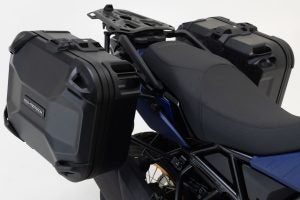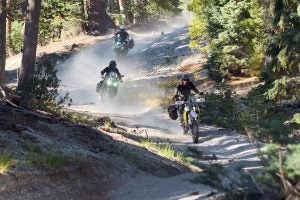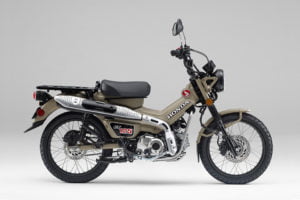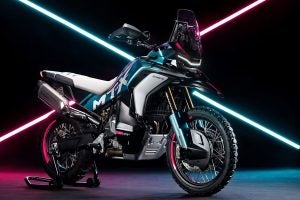When the new-for-2022 Kawasaki Z650 RS debuted last month, there was the usual chorus of yays and nays. One of the major complaints of the nay crowd was, “Wait, it’s a parallel twin, not a four-cylinder, like the original KZ650.”
This is true. It is also true that while the original KZ650 was a four-cylinder, the rest of the KZ series had several parallel twins in it, including the 400/440 series. Want something faster? Kawasaki also had a parallel twin KZ750, not to be confused with the four-cylinder KZ750. These bikes lasted for several years in Kawi’s lineup, but they’re almost forgotten today; survivors are increasingly falling prey to customizers, as they’re one of the last, affordable full-size UJMs left on the market.

Kawasaki’s KZ750 twin was a weird hybrid of modern and retro tech and look, without really being squarely in either camp.
A hybrid twin
What was the KZ750 twin, and why did Kawasaki build it, when it already had a four-cylinder 650 in the lineup?
Without a time machine and an inside line to the company’s plans of the late 1970s, we can only guess the answer to the second question.
But, as to the first: The KZ750 was a four-stroke parallel twin with relatively modern design when it debuted for 1976.
Unlike earlier parallel twins, the KZ750 had chain-driven counterbalancers to smooth out the vibration. Through the 1960s and 1970s, the Yamaha XS650 parallel twin was generally well-loved for its reliability and Brit bike styling, but riders hated its oppressive vibration. The KZ750 was supposed to avoid that, using a design very similar to Kawi’s KZ400 twin. Unfortunately, it only half-succeeded; the lower half of the rpm range was supposedly relatively smooth, but as revs rose, vibration became unpleasant.

The KZ750 twin came with chain-drive balancers that were less than impressive in their role of killing bad vibes. Sort of like an ineffective anti-depressant? Photo: Cycle Trader
Kawasaki also put a DOHC top end on the bike, a very modern feature back in the mid-’70s. Designers like double overhead cams if they’re building an engine with four-valve heads for better high-rpm airflow, gaining horsepower more efficiently as engine speed picks up. Unfortunately, the KZ750 only had two valves per cylinder, and only made 55 horsepower at 7,000 rpm. In its era, the four-cylinder KZ650 was considered a more sporty ride; the 750 was considered a dog in the performance department.
The 750 came with both electric and kickstart. This was common at that time, as e-start systems and motorcycle electrics in general were still a bit unreliable. However, while most motorcycle series deleted their kickstarter sometime in the late 1970s, the KZ750 kept it right up to the bitter end. I’ve seen a 750 twin advertised as a Canada-only 1984 LTD model, and even that late-production machine had a kickstarter on the engine.
Maybe this was a way of keeping pace with Yamaha’s XS650, which also retained its kickstarter to the end of its production run. The exterior of the KZ750 had a somewhat retro look to it, just like the XS, and presumably, Kawasaki did this to target some customers away from the XS. Whenever the 750 Kawasaki twin comes up in online discussion, you always see comparisons between the two, so if that was a marketing plan, it’s still working today, 30-plus years later.

For $4,000, you only get the custom scrambler in the foreground, alas. Photo: Cycle Trader
Kawasaki’s 750 twin engine had a five-speed gearbox and a long set of chromed exhaust pipes (at least on earlier standard models). The earliest models got Kawasaki’s long, straight bench seat, and a plastic ducktail tucked over the chrome rear fender. Overall, it was built along the same general lines as most of Kawi’s lineup from that era. There was plenty of shiny trim, a set of spoked wheels, and disc brakes front and rear. Claimed wet weight was 505 pounds.
Except for some relatively forward-thinking touches on the engine, compared to other twins of the era, there was nothing really noteworthy about the KZ750. It was a weird hybrid, really, with retro touches and modern engineering, but not really a full retro bike or a next-generation machine either.
In the US, the KZ750 twin sold from 1976 through 1983; other markets may have had later-production models. Considering how quickly motorcycle lineups turned over in that era, a seven-year production run is actually very respectable, even though the public never really took to the bike. Again, for another comparison with the XS650: Production ended around roughly the same time. Looks like maybe this was Kawasaki’s target with the 750, after all?

Reality is, this is the fate for many budget-friendly Japanese UJMs these days. The 750 twin is quite a bit faster than a CB350 or KZ440, so a desirable machine for a custom builder. Photo: Cycle Trader
This bike here?
This machine is a 1982 model, and it’s a good example of the ultimate fate of many of these motorcycles. Because they were unpopular in their original era, they never developed a cult following, and they’re one of the last quality Japanese-made bikes on the used market that’s still fast enough to not be boring, and affordable.
This bike started as a CSR model, one of the later-production 750 twins with cruiser styling. The owner ditched the pullback bars and stepped seat and went to work. Now, it’s a relatively tasteful scrambler, for sale in Florida for $4,000.

Here’s how this machine looked before its transformation. Photo: Cycle Trader
Here’s what the seller says about the machine:
The bike was stripped down to the motor and frame only, and rebuilt into a scrambler style. There are just too many replaced parts, and change-outs to list. Repainted and powdercoated components with minimal chrome left on her, scrambler style bars, bench seat designed on the original pan, knobby tires to do a little off-road if you like, 2 into 1 exhaust with new muffler and wrapped pipes, and the Airbox was swapped out for K&N pods (5 in total) giving her a very unique, head turning sound. She has an electric starter and a kick-starter if you want to impress your buddies with some old school action. She’s nimble, quick, and very steady on the road. She’ll do 80 on the highway if you are looking to do shorter road trips. She comes with a set of saddlebags, a tank bag, and a quick release windshield.
I’ve gone on record here before, stating my intense dislike of pod-style air filters, and frankly, I wouldn’t be surprised if the painted parts ended up looking a bit dodgy after gravel road riding. But hey, if you don’t like them, you can always paint them again. The claims of the bike being “nimble” might also be a stretch, as original-era riders thought the exact opposite.
Asking price is $4,000; the bike is located in Melbourne, Florida.







